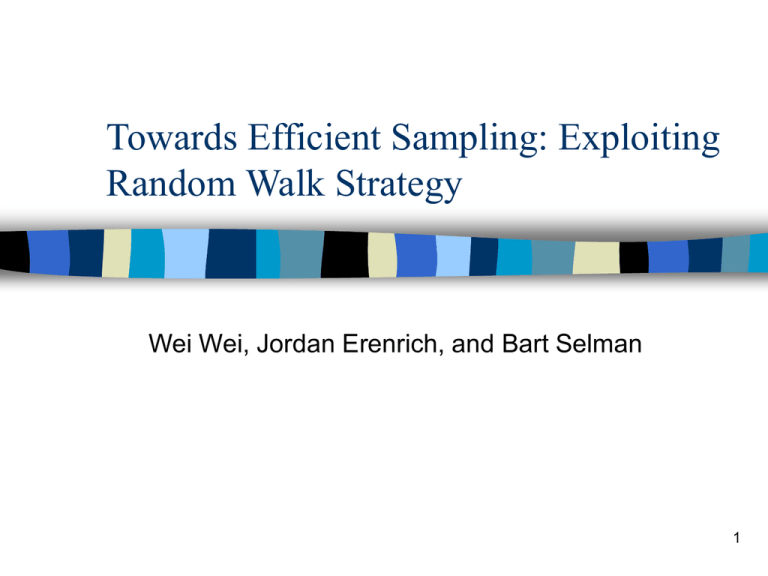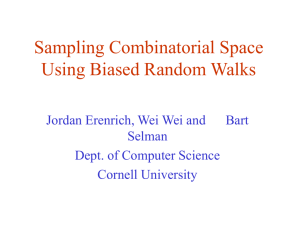Towards Efficient Sampling: Exploiting Random Walk Strategy 1
advertisement

Towards Efficient Sampling: Exploiting Random Walk Strategy Wei Wei, Jordan Erenrich, and Bart Selman 1 Motivations Recent years have seen tremendous improvements in SAT solving. Formulas with up to 300 variables (1992) to formulas with one million variables. Various techniques for answering “does a satisfying assignment exist for a formula?” But there are harder questions to be answered . “how many satisfying assignments does a formula have?” Or closely related “can we sample from the satisfying assignments of a formula?” 2 Complexity SAT is NP-complete. 2-SAT is solvable in linear time. Counting assignments (even for 2cnf) is #P-complete, and is NP-hard to approximate (Valiant, 1979). Approximate counting and sampling are equivalent if the problem is “downward self-reducible”. 3 Challenge Can we extend SAT techniques to solve harder counting/sampling problems? Such an extension would lead us to a wide range of new applications. SAT testing logic inference counting/sampling probabilistic reasoning 4 Standard Methods for Sampling MCMC Based on setting up a Markov chain with a predefined stationary distribution. Draw samples from the stationary distribution by running the Markov chain for sufficiently long. Problem: for interesting problems, Markov chain takes exponential time to converge to its stationary distribution 5 Simulated Annealing Simulated Annealing uses Boltzmann distribution as the stationary distribution. At low temperature, the distribution concentrates around minimum energy states. In terms of satisfiability problem, each satisfying assignment (with 0 cost) gets the same probability. Again, reaching such a stationary distribution takes exponential time for interesting problems. – shown in a later slide. 6 Standard Methods for Counting Current solution counting procedures extend DPLL methods with component analysis. Two counting precedures are available. relsat (Bayardo and Pehoushek, 2000) and cachet (Sang, Beame, and Kautz, 2004). They both count exact number of solutions. 7 Question: Can state-of-the-art local search procedures be used for SAT sampling/counting? (as alternatives to standard Monte Carlo Markov Chain and DPLL methods) Yes! Shown in this talk 8 Our approach – biased random walk Biased random walk = greedy bias + pure random walk. Example: WalkSat (Selman et al, 1994), effective on SAT. Can we use it to sample from solution space? – Does WalkSat reach all solutions? – How uniform is the sampling? 9 WalkSat visited 500,000 times visited 60 times Hamming distance 10 Probability Ranges in Different Domains Instance Runs Hits Rarest Hits Common Common-to -Rare Ratio Random 50 106 53 9 105 1.7 104 Logistics 1 106 84 4 103 50 Verif. 1 106 45 318 7 11 Improving the Uniformity of Sampling Nonergodic Ergodic Ergodic Quickly reach sinks Slow convergence WalkSat + SA = Does not satisfy DBC SampleSat SampleSat: – With probability p, the algorithm makes a biased random walk move – With probability 1-p, the algorithm makes a SA (simulated annealing) move 12 Comparison Between WalkSat and SampleSat WalkSat SampleSat 10 104 13 SampleSat 14 Hamming Distance Instance Runs Hits Rarest Hits Common Common-to -Rare Ratio WalkSat Ratio SampleSat Random 50 106 53 9 105 1.7 104 10 Logistics 1 106 84 4 103 50 17 Verif. 1 106 45 318 7 4 15 Analysis c1 c2 c3 … cn a b F F F … F F F F F F … F F T 16 Property of F* Proposition 1 SA with fixed temperature takes exponential time to find a solution of F* This shows even for some simple formulas in 2cnf, SA cannot reach a solution in poly-time 17 Analysis, cont. c1 c2 c3 … cn a T T T … T T F F F … F T F F F … F F Proposition 2: pure RW reaches this solution with exp. small 18 prob. SampleSat In SampleSat algorithm, we can devide the search into 2 stages. Before SampleSat reaches its first solution, it behaves like WalkSat. instance WalkSat SampleSat SA random 382 677 24667 logistics 5.7 104 15.5 105 > 109 verification 36 65 10821 19 SampleSat, cont. After reaching the solution, random walk component is turned off because all clauses are satisfied. SampleSat behaves like SA. Proposition 3 SA at zero temperature samples all solutions within a cluster uniformly. This 2-stage model explains why SampleSat samples more uniformly than random walk algorithms alone. 20 Verification on Larger formulas ApproxCount Small formulas -> Figures, solution frequencies. How to verify on large formulas? ApproxCount. ApproxCount approximates the number of solutions of Boolean formulas, based on SampleSat algorithm. Besides using it to justify the accuracy of our sampling approach, ApproxCount is interesting on its own right. 21 Algorithm The algorithm works as follows (Jerrum and Valiant, 1986): 1. 2. 3. 4. 5. Pick a variable X in current formula Draw K samples from the solution space Set variable X to its most sampled value t, and the multiplier for X is K/#(X=t). Note 1 multiplier 2 Repeat step 1-3 until all variables are set The number of solutions of the original formula is the product of all multipliers. 22 Accumulation of Errors #variables Sample error Overall error 200 10% 1% 1.9 105 7.3 400 10% 1% 3.6 1016 53.5 800 10% 1% 1.3 1033 2865 23 Within the Capacity of Exact Counters We compare the results of approxcount with those of the exact counters. instances #variables Exact count ApproxCount Average Error prob004-log-a 1790 2.6 1016 1.4 1016 0.03% wff.3.200.810 200 3.6 1012 3.0 1012 0.09% dp02s02.shuffled 319 1.5 1025 1.2 1025 0.07% 24 And beyond … We developed a family of formulas whose solutions are hard to count – The formulas are based on SAT encodings of the following combinatorial problem – If one has n different items, and you want to choose from the n items a list (order matters) of m items (m<=n). Let P(n,m) represent the number of different lists you can construct. P(n,m) = n!/(n-m)! 25 Hard Instances Encoding of P(20,10) has only 200 variables, but neither cachet or Relsat was able to count it in 5 days in our experiments. On the other hard, ApproxCount is able to finish in 2 hours, and estimates the solutions of even larger instances. instance #variables #solutions ApproxCount Average Error P(30,20) 600 7 1025 7 1024 0.4% P(20,10) 200 7 1011 2 1011 0.6% 26 Summary Small formulas -> complete analysis of the search space Larger formulas -> compare ApproxCount results with results of exact counting procedures Harder formulas -> handcraft formulas compare with analytic results 27 Conclusion and Future Work Shows good opportunity to extend SAT solvers to develop algorithms for sampling and counting tasks. Next step: Use our methods in probabilistic reasoning and Bayesian inference domains. 28
